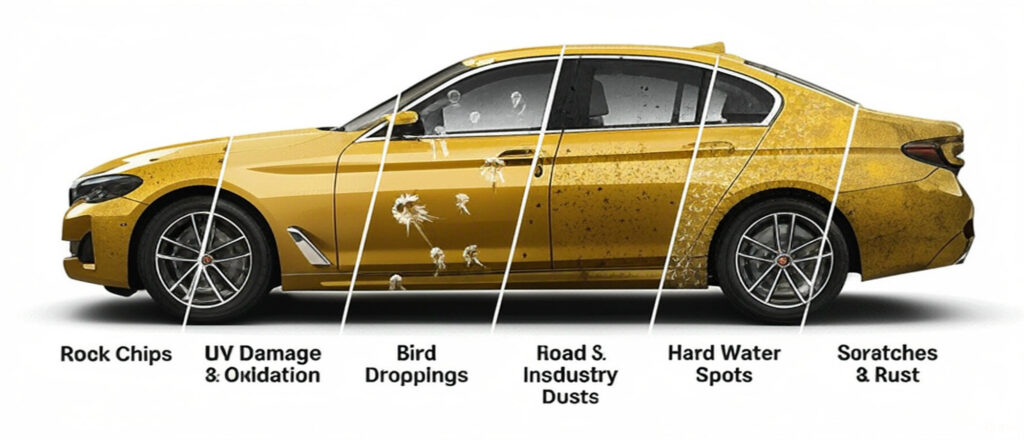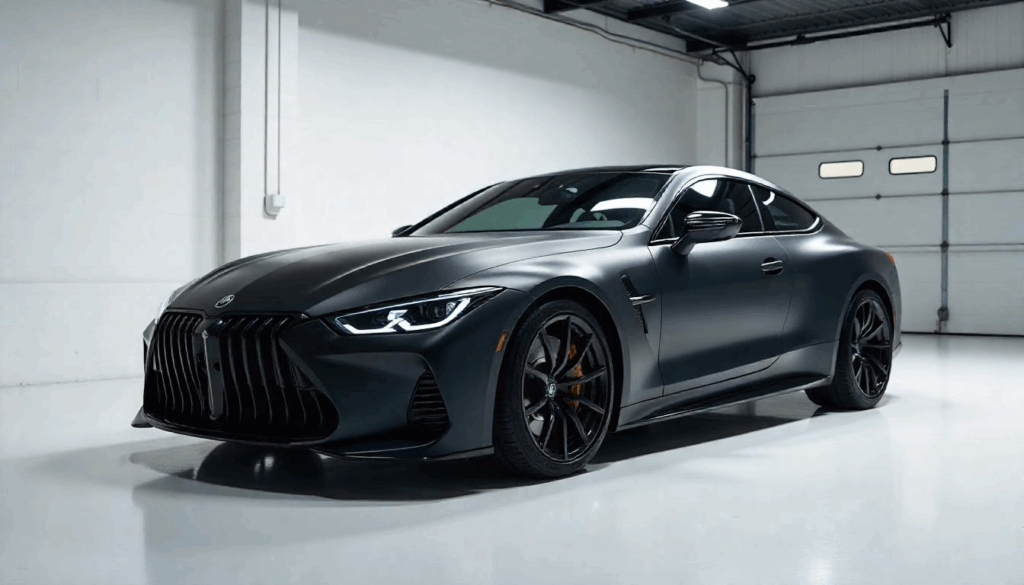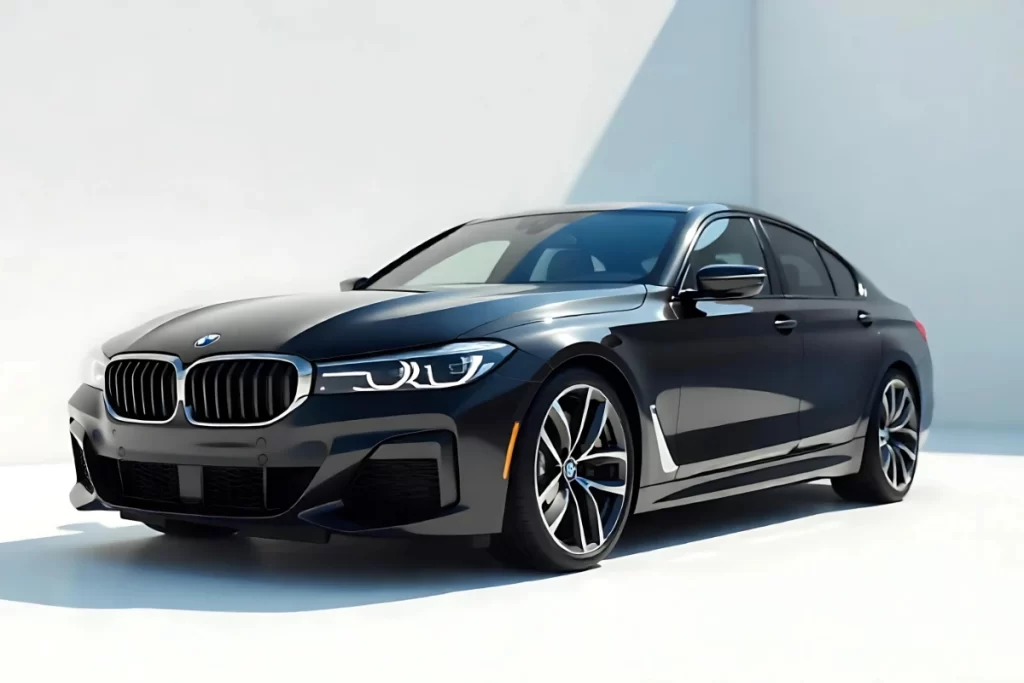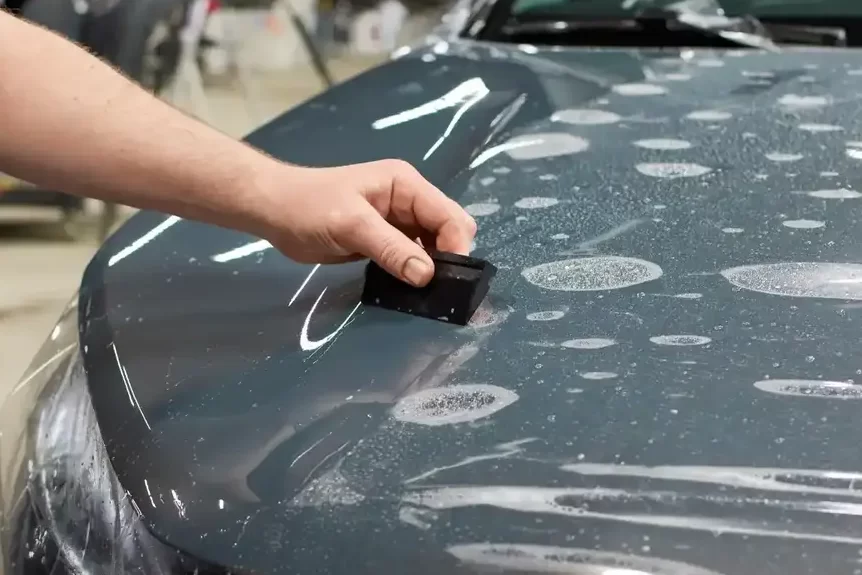1. Introduction
Your vehicle is more than just a method of transport; it’s an investment that makes a statement about your style and personality. So if we want to retain its value and beauty, protecting its paint from scratches, chips, and environmental damage is very important. Paint Protection Film in India has become a rage with car owners, keeping intact with the aesthetics while standing up to everyday abuse. The film comes with two popular finishes: matte and glossy, each giving distinct looks and advantages. Which one would be the more appropriate choice for your vehicle? This blog dives deeper into the matte versus glossy film argument: It compares their aesthetics, utilities, upkeep, and undue costs to help you reach your decision.
Paint Protection Film PPF For Car – Understanding the Concept
Consider the eventual installment of paint protection film for cars, as manufacturers lay flexible transparent thermoplastic polyurethane (TPU) films upon a vehicle’s exterior to protect its paint from scratches, chips, or environmental damage. Being multilayered, including self-healing polyurethane topcoat, durable TPU base, and adhesive, PPF absorbs the impact forces and withstands UV rays, staining, and corrosion. The self-healing property of such films ensures that minor scratches disappear with heat treatment, giving them a clean look. It also offers increased durability, maintains resale value by preserving paint quality, and ensures easy maintenance with dirt repellence and simple cleaning properties. The increased car ownership and the growing demand for top-notch protection for vehicles further strengthen the Indian PPF market, which is slowly gaining momentum, with ppf coating prices for car starting from ₹40,000 to ₹2,20,000, depending on vehicle size and quality of film.

Matte PPF: Features, Benefits, and Considerations
Matte finish-type PPF is a non-reflective finish that transforms a car’s appearance with its modern, understated elegance. Unlike glossy finishes, a matte PPF absorbs light and glare, giving the cars this cool, almost stealth-like appearance that really pops, especially for the high-end, some Swiss and German sports cars. Its smooth satin finish accentuates the contoured surfaces of the vehicle. Anyone looking for something apart from the traditional custom look favors this texture.
Some benefits are: it can hide slight imperfections such as swirl marks, as the light-diffusing matte finish does not allow reflection. It also better resists fingerprint smudges than glossy PPF finishes and thus keeps itself from looking dirty. It offers the same strong-option-protection type of PPF against scratches, UV rays, and road debris, together with some self-healing ability, where it repairs minor scratches with the application of heat.
Maintenance is a bit tricky as the matte finish shows water spots and dirt more glaringly. We suggest cleaning with specific cleaners that target matte finishes to avoid bringing up a gloss or further deteriorating the film.

Glossy PPF: Characteristics, Advantages, and Warnings
Glossy PPF offers a lively, mirror-like finish, creating a visual attraction for the vehicle-with the colours practically pulsating and the curves standing out. Such a high-gloss finish further adds depth to factory paint, giving the cars a sleek show-floor appearance, attractive to both purists and common viewers alike. The reflective finishing gives a special shine to the vehicle, making it visually attractive, especially with loud or metallic colors.
Increased paint vibrancy benefits, as glossy PPF intensifies colour and clarity while standing guard against scratches and UV rays or hanging low against road debris. Thanks to the smooth texture and inclined surface, cleaning is a breeze with dirt and grime sliding off with just a mild car wash.
Considerations include scratches and swirl marks that may be most susceptible under a highly glossy finish, owing to its reflective properties. Fingerprints and smudges can also be a bother; thus, their accumulation calls for frequent cleaning. Despite being long-lasting, glamorous PPF may also show signs of wear in frequently-trafficked areas, and repairs will call for color-matching that needs to be impeccable, lest the patched-up areas stand out. Nevertheless, going by them is such an easy task, lending to their glorious charm and ease of maintenance, making glossy PPF a popular choice.

Comparative Analysis: Matte vs. Glossy PPF
| Aspect | Matte PPF | Glossy PPF |
| Aesthetic Appeal | Offers a subtle, non-reflective satin finish, delivering a modern, stealth-like look. Ideal for luxury or sports cars seeking a sophisticated, unique vibe. Hides minor imperfections like swirl marks. | Provides a vibrant, high-shine finish that enhances paint depth and vibrancy. Creates a showroom-polished, mirror-like effect, perfect for bold or metallic colors. |
| Protection Level | Equally durable as glossy, shielding against scratches, chips, UV rays, and debris. Self-healing properties repair minor scratches with heat. Matte’s texture may mask light abrasions better. | Matches matte in durability, offering robust protection against scratches, UV rays, and environmental damage. Self-healing technology repairs light scratches, though visible on reflective surfaces. |
| Maintenance | Matches match in durability, offering robust protection against scratches, UV rays, and environmental damage. Self-healing technology repairs light scratches, though visible on reflective surfaces. | Requires specific matte-safe cleaning products to preserve the non-reflective finish. Shows water spots and dirt more prominently, needing regular care to avoid glossing. Less prone to fingerprints. |
| Cost Analysis | Typically 10–20% pricier due to specialized finish. In India, matte PPF costs ₹76,000–₹1,05,000 for sedans, ₹85,000–₹1,50,000 for SUVs (e.g., Garware, UCFilms). Installation adds ₹75,000–₹1,00,000. | More cost-effective, ranging ₹55,000–₹95,000 for sedans, ₹75,000–₹1,95,000 for SUVs (e.g., 3M, LLumar). Installation costs similar to matte. ppf coating price vary by brand and vehicle size. |
| Resale Value Impact | Enhances resale value by preserving paint, appealing to buyers seeking unique aesthetics. May attract niche buyers but risks lower mass-market appeal due to unconventional look. | Boosts resale value by maintaining a pristine, glossy finish that aligns with broader market preferences. Showroom shine often commands higher prices, especially for luxury cars. |
Real-World Trends and Consumer Preferences
Consumer choices in the Indian market for matte or glossy finishes on vehicles are a mixture of aesthetics and pragmatic considerations. According to a 2024 survey by AutoPaintTech, 62% of Indian car owners chose glossy PPF due to its vibrant finish that is easy to maintain, while 38% chose matte PPF because of its ultra-modern, non-reflective aesthetic, especially amongst luxury and high-performance car owners. Matte Paint Protection Film in India is slowly catching on in metropolitan centres such as Delhi and Mumbai, where custom aesthetics are important, while glossy takes precedence among smaller towns and cities for budget reasons and ease of maintenance.
Regional differences reveal that consumers in southern states like Karnataka and Tamil Nadu slightly prefer matte (45%) for premium vehicles, driven by a tech-oriented base; the north contrasts with Punjab, where consumers prefer glossy (70%) for bright colours. As electric vehicle ownership rises, especially for sleek designs such as the Hyundai Ioniq 5, consumers demand matte finishes to complement the futuristic aesthetics, also boosting India’s burgeoning EV market.
Factors to Consider When Choosing Between Matte and Glossy PPF
Your aesthetic perception influences the choice of matte versus glossy finishes. Matte leans towards being cool, unobtrusive, and dulled; glossy, on the other hand, chooses vibrancy and gloss for its presence. Think of the automobile’s aesthetics: matte is for luxury and customized cars; glossy is for bolder colors. Consider the driving conditions and environmental influences. If regularly on highways or in dusty environs, opt for matte, since dirt and imperfections do not show easily. If urban or nearly urban, then glossy will be better and easier to clean. Budget issue: matte PPF is 10–20% pricier (₹76,000–₹1,50,000 in India), but in any way, they will provide long-term value by protecting paint and enhancing resale value prices. Inquire about professional PPF services in your area for installation, as bespoke service (with equipment and workmanship standards) will be invaluable in hunting for your vehicle’s specific needs and conditions.
Installation and Services
Installation professionals must install PPF for a seamless bubble-free finish, because incorrect installation can cause PPF to not last long. The procedure includes cleaning the surface of the vehicle, cutting the film into the exact size and form to fit with the surface, and finally applying heat for the adhesive to develop between 1 and 2 days, depending on the size of the coverage. After installation, we make some minor adjustments to maximize adhesion. Precision in application will prevent early peeling or misalignment by technicians, thus maximizing the life of the film. Korean brands of PPF are getting popular in India for providing high-clarity self-healing films with cost-effective occidental options. Make sure that you seek only certified installers to guarantee quality, performing complex matte or glossy finishes.

Conclusion
The choice between matte and glossy PPF depends on the tradeoff between aesthetics, maintenance, and budget. Matte PPF features a new-age non-reflective surface and masks surface imperfections, whereas glossy PPF offers colorful shine and easy cleaning, with scratches appearing straight on. Theoretically, both provide solid protection and increase resale value, with matte being more expensive (₹76,000–₹1,50,000) and glossy a little less expensive (₹55,000–₹1,95,000). Going by consumer preferences, glossy is the preferred one for being time-cost, while matte is carving out its own Indie space in the urban big cities. Personal styles, driving habits, and environmental considerations remain some focal points to consider.
Frequently Asked Questions (FAQs)
Q1: What is the average paint protection film cost in India?
A: PPF costs in India range from ₹45,000 to ₹2,20,000, depending on vehicle size, film quality, and brand. Glossy PPF starts at ₹55,000 for sedans, while matte is pricier, from ₹76,000–₹1,50,000. Installation adds ₹50,000–₹1,00,000.
Q2: How long does PPF last on a vehicle?
A: With proper maintenance, PPF lasts 5–10 years. Premium films with self-healing properties can extend beyond 10 years, depending on climate and care.
Q3: Can I switch from glossy to Matte PPF later?
A: Yes, professionals can remove glossy PPF and replace it with matte PPF without damaging the original paint, though it incurs additional costs.
Q4: Are there specific Korean PPF brands suitable for Indian climates?
A: Korean PPF brands offer high-clarity, UV-resistant films with self-healing properties, ideal for India’s harsh climates, ensuring durability against heat and dust.
Q5: Does PPF affect the car’s original paint warranty?
A: PPF does not typically void the car’s paint warranty, as it’s removable without damaging the paint. Always confirm with your manufacturer before application.
